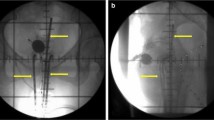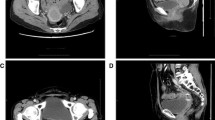Background:
When photon radiotherapy is applied to cervical carcinoma, it has been observed that, despite important progress in radiotherapy technique and quality assurance, no significant increase in curative rates has resulted. Among the reasons for this is the varying radiosensitivity of different tumor subpopulations. Treatment with californium-252 (252Cf), as a source of gamma/neutron radiation in brachytherapy, provides properties and new treatment modalities that help to overcome this factor.
Patients and Methods: From January 1985 to June 1993, 227 women with stage IIB and IIIB cervical carcinoma were treated in a randomized brachytherapy study as follows: (1) 117 patients (55 with stage IIB, 62 with stage IIIB) were treated with 252Cf during the 1st week of therapy by 6 Gy (40 Gy-eq) of the neutron component in point A. Supplementation by a 16-Gy dose with 226Ra or 137Cs was done in the 5th week. (2) 110 patients (50 with stage IIB, 60 with stage IIIB) were treated solely by gamma radiation (226Ra or 137Cs). A dose of 56 Gy in point A was applied in two fractions at the 3rd and 5th week, respectively. The dose of 56 Gy-equivalents was completed by external radiation with 40 Gy. The total radiation doses at points A and B amounted to 85 Gy and 59 Gy, respectively. The treatment results were compared.
Results: The overall 5-year survival rate for all stages IIB and IIIB was better by 18.9% for 252Cf patients than for patients receiving conventional treatment (75.2% vs. 56.3%, respectively; p < 0.001). In the stage IIIB 252Cf group, it was significantly better by 22.8% than for the conventional group (66.1% vs. 43.3%, respectively; p < 0.003). The higher survival rate in 252Cf patients was the result of significantly less local relapses compared with patients treated conventionally (12,8% vs. 31.8%; p < 0.0009).
Conclusion: The importance of neutron source 252Cf in the brachytherapy of cervical carcinoma by overcoming the tumor resistance to conventional photon irradiation has been confirmed.
Hintergrund:
Trotz wichtiger Fortschritte in den strahlentherapeutischen Techniken und der Qualitätssicherung ließen sich durch die konventionelle Photonentherapie beim Zervixkarzinom keine signifikanten Verbesserungen der Heilungsraten erzielen. Einer der Gründe hierfür ist die unterschiedliche Strahlenempfindlichkeit unterschiedlicher Tumorsubpopulationen. Die Neutronenbrachytherapie mit Californium-252 (252Cf) stellt eine neue Therapiemodalität dar, die dem Therapeuten helfen kann, diese Strahlenresistenz zu überwinden.
Patienten und Methodik: Zwischen Januar 1985 bis Juni 1993 wurden 227 Patientinnen mit Zervixkarzinom im Stadium IIB und IIIB im Rahmen einer randomisierten Brachytherapiestudie wie folgt behandelt: 1. 117 Patientinnen (55 im Stadium IIB, 62 im Stadium IIIB) wurden in der 1. Woche mit 252Cf in einer Dosis von 6 Gy (40 Gy-Eq) der Neutronenkomponente in Punkt A behandelt. Eine Erhöhung der Dosis um 16 Gy in Punkt A mit 226Ra oder 137Cs erfolgte in der 5. Behandlungswoche. 2. 110 Patientinnen (50 im Stadium IIB, 60 im Stadium IIIB) wurden ausschließlich mit Gammabrachytherapie (226Ra oder 137Cs) behandelt. Die Dosis von 56 Gy in Punkt A wurde in zwei Fraktionen in der 3. und 5. Behandlungswoche verabreicht. Die Brachytherapiedosis von 56 Gy-Äquivalenten wurde in beiden Gruppen durch perkutane Bestrahlung mit 40 Gy ergänzt. Die Gesamtreferenzdosen in den Punkten A und B betrugen 85 Gy und 59 Gy. Die Ergebnisse der Behandlung zwischen beiden Gruppen wurden verglichen.
Ergebnisse: Die 5-Jahres-Gesamtüberlebensrate aller Patientinnen im Stadium IIB war bei 252Cf-Patientinnen um 18,9% besser als bei Patientinnen, die ausschließlich eine konventionelle Behandlung erhielten (75,2% vs. 56,3%; p < 0,001). Im Stadium IIIB war die 5-Jahres-Überlebensrate in der 252Cf-Gruppe um 22,8% besser als in der konventionellen Gruppe (66,1% vs. 43,3%; p < 0,003). Die besseren Überlebensraten bei 252Cf-Patientinnen waren durch signifikant niedrigere lokale Rezidivraten bedingt (12,8% vs. 31,8%; p < 0,0009).
Schlussfolgerung: Der Stellenwert der 252Cf-Neutronen-Brachytherapie beim Zervixkarzinom wurde nachgewiesen.
Similar content being viewed by others
Author information
Authors and Affiliations
Additional information
Received: February 13, 2002; accepted: February 21, 2003
Address for Correspondence Tačco Tačev, MD, D.Sc., Masaryk Memorial Cancer Institute, Zluty kopec 7, 656 53 Brno, Czech Republic, Phone (+420/5) 4313-1111, Fax 4321-1169, e-mail: tacev@mou.cz
Rights and permissions
About this article
Cite this article
Tačev, T., Ptáčková, B. & Strnad, V. Californium-252 (252Cf) versus Conventional Gamma Radiation in the Brachytherapy of Advanced Cervical Carcinoma . Strahlenther Onkol 179, 377–384 (2003). https://doi.org/10.1007/s00066-003-1005-4
Issue Date:
DOI: https://doi.org/10.1007/s00066-003-1005-4




